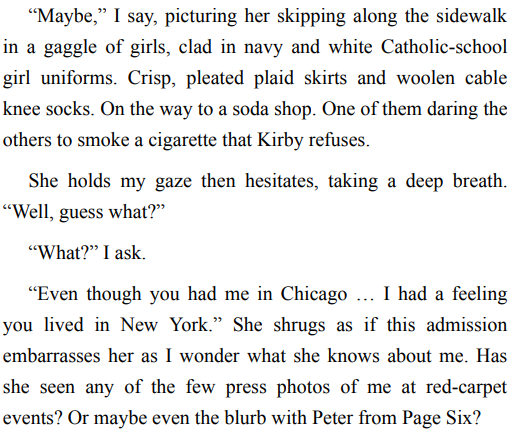

For all Marian’s success and sophistication, and Kirby’s aimlessness and disinterest in attending college, in some ways Kirby has more on the ball than her biological mother.

Of course, Kirby senses this and it amplifies her feelings of alienation. She’s compartmentalized the pain of her loss, and she tries to compartmentalize Kirby as well, by taking her shopping at Barney’s and to see the Met instead of being truthful with her. Louis to New York without telling them, and looks Marian up.īecause Marian concealed her pregnancy, she’s not eager to discuss it, or the biological father’s identity, with Kirby. She wonders who her biological parents were, and after overhearing her parents worrying about what kind of people may have conceived her, she takes a bus from St. Kirby is a disaffected teen, envious of the attention her sister (her parents’ biological child, born after they adopted Kirby) gets.

That she kept it secret from Peter, from her own father, and from Kirby’s biological father makes it hard for her to cope with Kirby’s reappearance in her life. Marian hasn’t met Kirby since she gave her away, and though she left her contact information with the adoption agency, she has never told anyone but her mother about her pregnancy. Kirby’s appearance on Marian’s doorstep is unexpected. It is there, at eleven o’clock at night, that Kirby arrives at Marian’s door. The two of them have a fight and Marian takes a cab to her Manhattan penthouse. But Peter, recently divorced, is commitment-shy. The book alternates between the two characters’ first person present tense POVs and begins with Marian angling for a proposal from her boyfriend of two years, Peter.

Where We Belong has two heroines: Marian Caldwell, a successful television producer who gave up a child for adoption when she was eighteen, and Kirby Rose, the girl Marian gave away, now eighteen herself. The rest of the book is about what happens after that. Whereas in Find a Stranger, Say Goodbye Natalie meets with her birth mother late in the story, here, in Where We Belong, adoptee and birth mother meet by the end of Chapter One. Like Lowry’s book, Where We Belong deals with adoption, but it is written from a different perspective. Happily, Where We Belong proved enjoyable and thought-provoking. I was disappointed in Baby Proof, though, enough that I feel a little trepidation whenever I approach a new book of yours. Prior to this I had read four of your books, and enjoyed three of them, most especially Something Blue, the sequel to Something Borrowed. I was reminded of Lowry’s book when reading your sixth novel, Where We Belong. The book chronicled the teenaged Natalie’s search for her birth mother, her meeting with the woman who gave birth to her and gave her up for adoption, and ended with Natalie’s realization that she belonged with the family she’d always had. Decades ago, when I was a teen, I read a wonderful book by Lois Lowry called Find a Stranger, Say Goodbye.


 0 kommentar(er)
0 kommentar(er)
